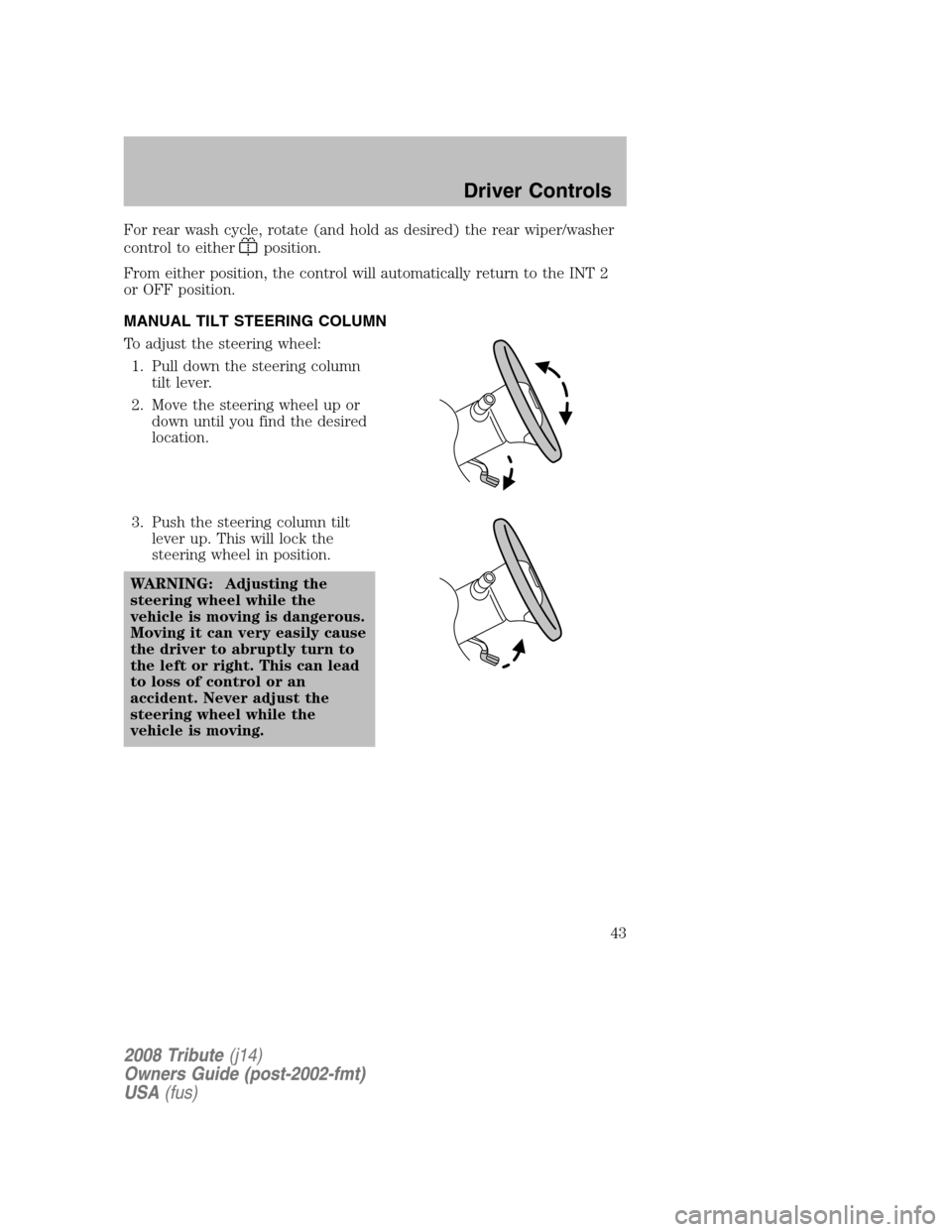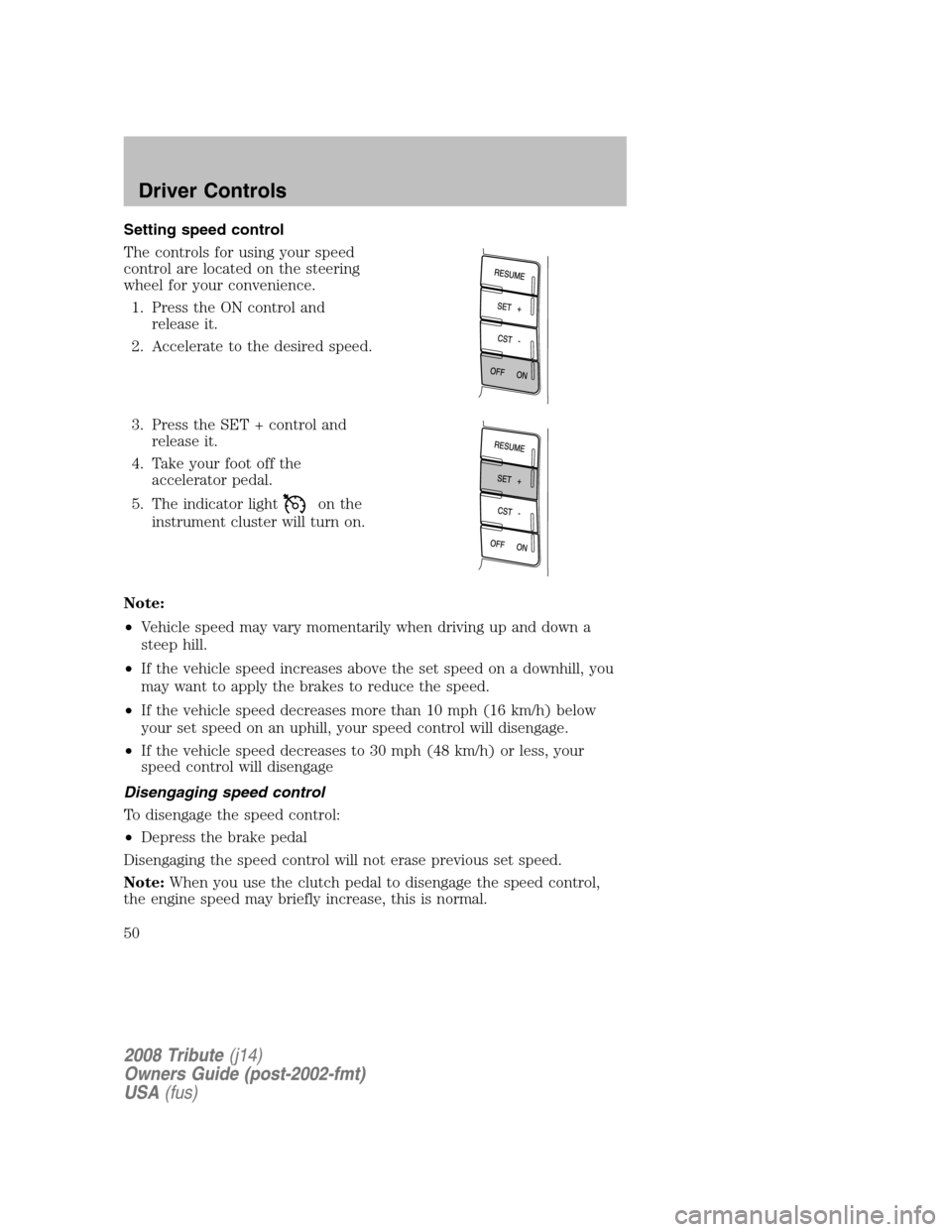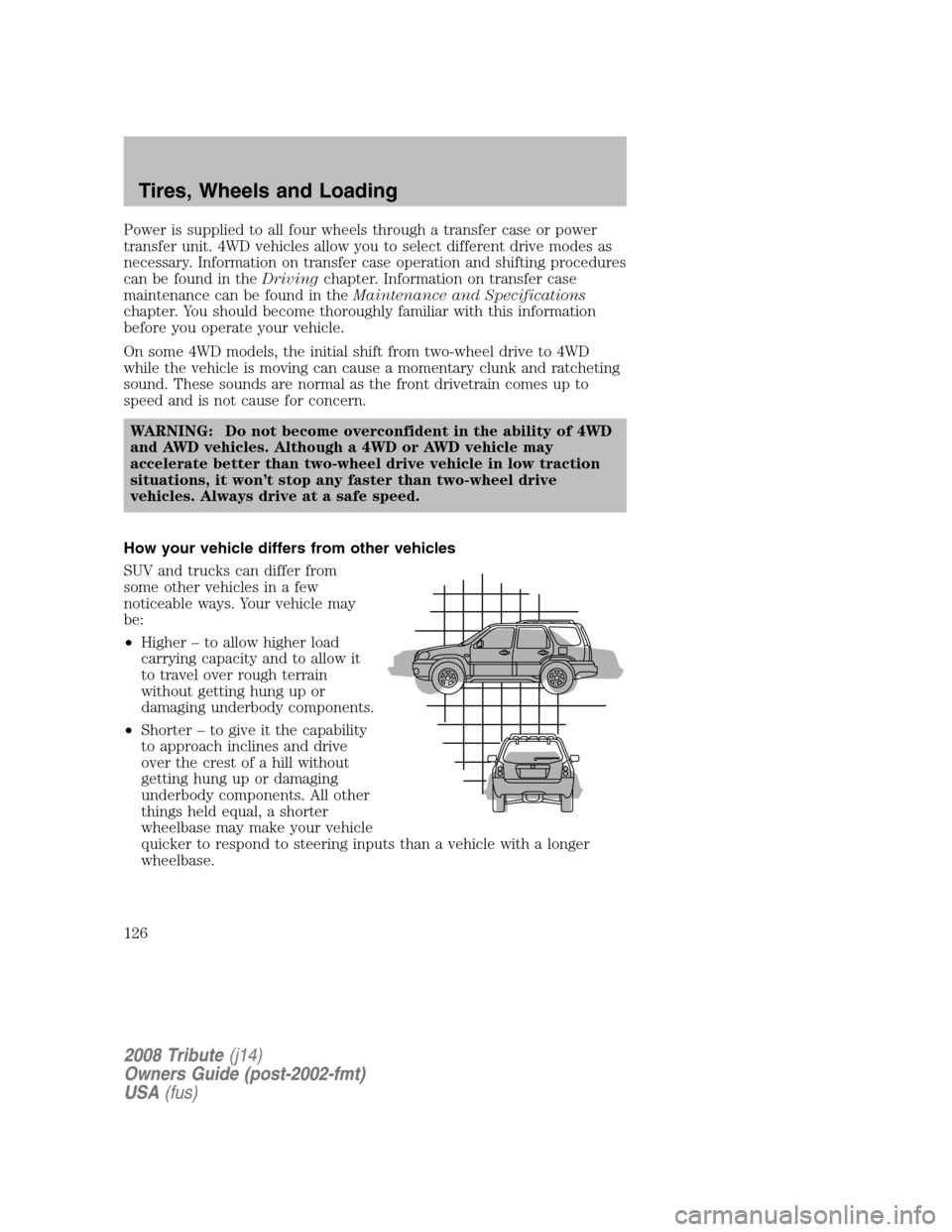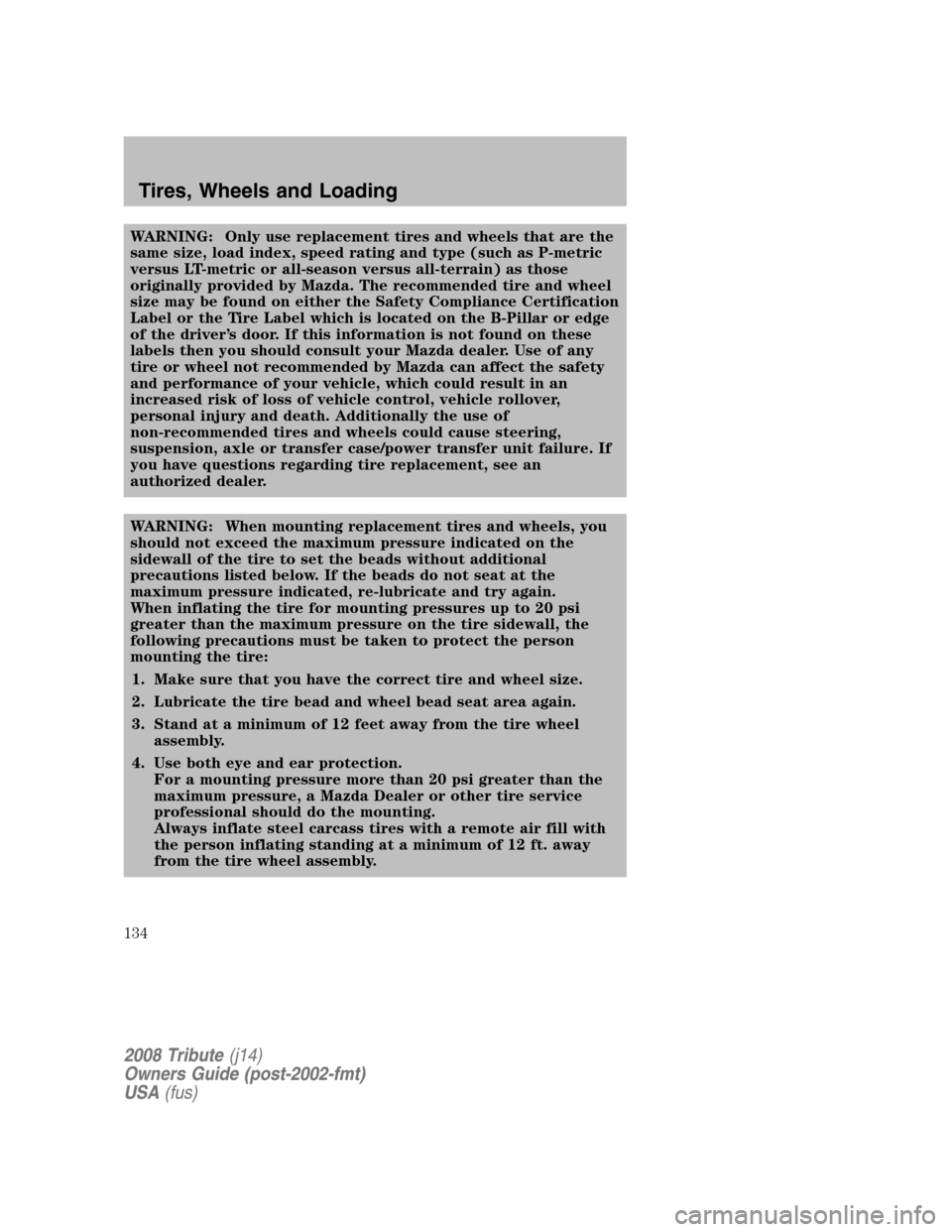steering wheel MAZDA MODEL TRIBUTE 2008 Owners Manual (in English)
[x] Cancel search | Manufacturer: MAZDA, Model Year: 2008, Model line: MODEL TRIBUTE, Model: MAZDA MODEL TRIBUTE 2008Pages: 288, PDF Size: 3.9 MB
Page 1 of 288

Introduction 4
Instrument Cluster 12
Warning lights and chimes 12
Gauges 17
Entertainment Systems 19
Auxiliary input jack 25
Climate Controls 29
Manual heating and air conditioning 29
Rear window defroster 31
Lights 32
Headlamps 32
Turn signal control 35
Bulb replacement 36
Driver Controls 42
Windshield wiper/washer control 42
Steering wheel adjustment 43
Power windows 47
Mirrors 48
Cruise control 49
Moon roof 53
Locks and Security 60
Keys 60
Locks 62
Anti-theft system 68
Seating and Safety Restraints 72
Seating 72
Safety restraints 81
Airbags 97
Child restraints 113
Table of Contents
1
2008 Tribute (j14)
Owners Guide (post-2002-fmt)
USA (fus)
Page 10 of 288

Multi-function lever (pg. 42) Instrument cluster
(pg. 12)
Hazard flasher control (pg. 188)
Headlamp control
(pg. 32)
Parking brake release (pg. 167) Speed controls*
(pg. 49) Hood release
(pg. 239) Steering wheel controls*
(pg. 52)
* if equipped
2008 Tribute (j14)
Owners Guide (post-2002-fmt)
USA (fus)
Instrument Cluster
10
Page 43 of 288

For rear wash cycle, rotate (and hold as desired) the rear wiper/washer
control to either
position.
From either position, the control will automatically return to the INT 2
or OFF position.
MANUAL TILT STEERING COLUMN
To adjust the steering wheel: 1. Pull down the steering column tilt lever.
2. Move the steering wheel up or down until you find the desired
location.
3. Push the steering column tilt lever up. This will lock the
steering wheel in position.
WARNING: Adjusting the
steering wheel while the
vehicle is moving is dangerous.
Moving it can very easily cause
the driver to abruptly turn to
the left or right. This can lead
to loss of control or an
accident. Never adjust the
steering wheel while the
vehicle is moving.
2008 Tribute (j14)
Owners Guide (post-2002-fmt)
USA (fus)
Driver Controls
43
Page 50 of 288

Setting speed control
The controls for using your speed
control are located on the steering
wheel for your convenience. 1. Press the ON control and release it.
2. Accelerate to the desired speed.
3. Press the SET + control and release it.
4. Take your foot off the accelerator pedal.
5. The indicator light
on the
instrument cluster will turn on.
Note:
• Vehicle speed may vary momentarily when driving up and down a
steep hill.
• If the vehicle speed increases above the set speed on a downhill, you
may want to apply the brakes to reduce the speed.
• If the vehicle speed decreases more than 10 mph (16 km/h) below
your set speed on an uphill, your speed control will disengage.
• If the vehicle speed decreases to 30 mph (48 km/h) or less, your
speed control will disengage
Disengaging speed control
To disengage the speed control:
• Depress the brake pedal
Disengaging the speed control will not erase previous set speed.
Note: When you use the clutch pedal to disengage the speed control,
the engine speed may briefly increase, this is normal.
2008 Tribute (j14)
Owners Guide (post-2002-fmt)
USA (fus)
Driver Controls
50
Page 52 of 288

•Depress the brake pedal or the
clutch pedal (if equipped) until
the desired vehicle speed is
reached, press the SET + control.
Turning off speed control
There are two ways to turn off the
speed control:
• Press the speed control OFF
control.
• Turn OFF the ignition.
Note: When you turn off the speed
control or the ignition, your speed
control set speed memory is erased.
STEERING WHEEL CONTROLS (IF EQUIPPED)
These controls allow you to operate some audio control features.
Radio control features
Press MEDIA to select:
• AM, FM1, FM2, or CD
• LINE IN (Auxiliary input jack) (if
equipped)
2008 Tribute (j14)
Owners Guide (post-2002-fmt)
USA (fus)
Driver Controls
52
Page 98 of 288

WARNING: The driver should always hold onto only the rim of
the steering wheel. Never place your arm over the airbag
module or anywhere inside the rim as a deploying airbag can
result in serious arm fractures or other injuries.
Steps you can take to properly position yourself away from the airbag:
• Move your seat to the rear as far as you can while still reaching the
pedals comfortably.
• Recline the seat slightly (one or two notches) from the upright
position.
WARNING: Do not put anything on or over the airbag module
including hands or feet. Placing objects on or over the airbag
inflation area may cause those objects to be propelled by the
airbag into your face and torso causing serious injury.
WARNING: Do not attempt to service, repair, or modify the
Airbag Supplemental Restraint Systems or its fuses. See your
authorized Mazda dealership.
WARNING: Modifications to the front end of the vehicle,
including frame, bumper, front end body structure, tow hooks,
and snow plows may affect the performance of the airbag
sensors increasing the risk of injury. Do not modify the front
end of the vehicle.
WARNING: Additional equipment may affect the performance
of the airbag sensors increasing the risk of injury. Consult your
authorized Mazda dealership before installation of additional
equipment.
2008 Tribute (j14)
Owners Guide (post-2002-fmt)
USA (fus)
Seating and Safety Restraints
98
Page 126 of 288

Power is supplied to all four wheels through a transfer case or power
transfer unit. 4WD vehicles allow you to select different drive modes as
necessary. Information on transfer case operation and shifting procedures
can be found in the Drivingchapter. Information on transfer case
maintenance can be found in the Maintenance and Specifications
chapter. You should become thoroughly familiar with this information
before you operate your vehicle.
On some 4WD models, the initial shift from two-wheel drive to 4WD
while the vehicle is moving can cause a momentary clunk and ratcheting
sound. These sounds are normal as the front drivetrain comes up to
speed and is not cause for concern.
WARNING: Do not become overconfident in the ability of 4WD
and AWD vehicles. Although a 4WD or AWD vehicle may
accelerate better than two-wheel drive vehicle in low traction
situations, it won’t stop any faster than two-wheel drive
vehicles. Always drive at a safe speed.
How your vehicle differs from other vehicles
SUV and trucks can differ from
some other vehicles in a few
noticeable ways. Your vehicle may
be:
• Higher – to allow higher load
carrying capacity and to allow it
to travel over rough terrain
without getting hung up or
damaging underbody components.
• Shorter – to give it the capability
to approach inclines and drive
over the crest of a hill without
getting hung up or damaging
underbody components. All other
things held equal, a shorter
wheelbase may make your vehicle
quicker to respond to steering inputs than a vehicle with a longer
wheelbase.
2008 Tribute (j14)
Owners Guide (post-2002-fmt)
USA (fus)
Tires, Wheels and Loading
126
Page 134 of 288

WARNING: Only use replacement tires and wheels that are the
same size, load index, speed rating and type (such as P-metric
versus LT-metric or all-season versus all-terrain) as those
originally provided by Mazda. The recommended tire and wheel
size may be found on either the Safety Compliance Certification
Label or the Tire Label which is located on the B-Pillar or edge
of the driver’s door. If this information is not found on these
labels then you should consult your Mazda dealer. Use of any
tire or wheel not recommended by Mazda can affect the safety
and performance of your vehicle, which could result in an
increased risk of loss of vehicle control, vehicle rollover,
personal injury and death. Additionally the use of
non-recommended tires and wheels could cause steering,
suspension, axle or transfer case/power transfer unit failure. If
you have questions regarding tire replacement, see an
authorized dealer.
WARNING: When mounting replacement tires and wheels, you
should not exceed the maximum pressure indicated on the
sidewall of the tire to set the beads without additional
precautions listed below. If the beads do not seat at the
maximum pressure indicated, re-lubricate and try again.
When inflating the tire for mounting pressures up to 20 psi
greater than the maximum pressure on the tire sidewall, the
following precautions must be taken to protect the person
mounting the tire: 1. Make sure that you have the correct tire and wheel size.
2. Lubricate the tire bead and wheel bead seat area again.
3. Stand at a minimum of 12 feet away from the tire wheel assembly.
4. Use both eye and ear protection. For a mounting pressure more than 20 psi greater than the
maximum pressure, a Mazda Dealer or other tire service
professional should do the mounting.
Always inflate steel carcass tires with a remote air fill with
the person inflating standing at a minimum of 12 ft. away
from the tire wheel assembly.
2008 Tribute (j14)
Owners Guide (post-2002-fmt)
USA (fus)
Tires, Wheels and Loading
134
Page 164 of 288

Starting the engine 1. Turn the key to 3 (RUN) without turning the key to
4 (START). If there is difficulty
in turning the key, rotate the
steering wheel until the key
turns freely. This condition may
occur when:
• the front wheels are turned
• a front wheel is against the curb
2. Turn the key to 4 (START), then release the key as soon as the engine starts. Excessive cranking
could damage the starter.
Note: If the engine does not start within five seconds on the first try,
turn the key to 1 (LOCK), wait 10 seconds and try again. If the engine
still fails to start, press the accelerator to the floor and try again; this will
allow the engine to crank with the fuel shut off in case the engine is
flooded with fuel.
If your vehicle has an automatic transmission, it will have a computer
assisted cranking system. This feature assists in starting the engine. If
the ignition key is turned to 4 (START) and then released when the
engine begins cranking, the engine may continue cranking for up to
10 seconds or until the vehicle starts.
Guarding against exhaust fumes
Although odorless and colorless, carbon monoxide is present in exhaust
fumes. Take precautions to avoid its dangerous effects.
WARNING: If you ever smell exhaust fumes of any kind inside
your vehicle, have your authorized dealer inspect and fix your
vehicle immediately. Do not drive if you smell exhaust fumes.
These fumes are harmful and result in accident or death.
Have the exhaust and body ventilation systems checked whenever:
• the vehicle is raised for service.
• the sound of the exhaust system changes.
• the vehicle has been damaged in a collision.
2008 Tribute (j14)
Owners Guide (post-2002-fmt)
USA (fus)
Driving
164
Page 166 of 288

BRAKES
Occasional brake noise is normal. If a metal-to-metal, continuous grinding
or continuous squeal sound is present, the brake linings may be worn-out
and should be inspected by an authorized dealer. If the vehicle has
continuous vibration or shudder in the steering wheel while braking, the
vehicle should be inspected by an authorized dealer.
Refer to Brake system warning
light in the Instrument Cluster
chapter for information on the brake
system warning light.
Four-wheel anti-lock brake system (ABS)
Since your vehicle is equipped with an Anti-lock Braking System (ABS),
a noise from the hydraulic pump motor and pulsation in the pedal may
be observed during ABS braking events. Pedal pulsation coupled with
noise while braking under panic conditions or on loose gravel, bumps,
wet or snowy roads is normal and indicates proper functioning of the
vehicle’s anti-lock brake system.
NOTE: The ABS performs a self-check after you start the engine and
begin to drive away.
A brief mechanical noise may be heard during this test. This is normal. If
a malfunction is found, the ABS warning light will come on. If the vehicle
has continuous vibration or shudder in the steering wheel while braking,
the vehicle should be inspected by an authorized dealer.
The ABS operates by detecting the
onset of wheel lockup during brake
applications and compensates for
this tendency. The wheels are
prevented from locking even when
the brakes are firmly applied. The
accompanying illustration depicts
the advantage of an ABS equipped
vehicle (on bottom) to a non-ABS
equipped vehicle (on top) during hard braking with loss of front braking
traction.
WARNING: The Anti-Lock system does not decrease the time
necessary to apply the brakes or always reduce stopping
distance. Always leave enough room between your vehicle and
the vehicle in front of you to stop.
P!
BRAKE
2008 Tribute (j14)
Owners Guide (post-2002-fmt)
USA (fus)
Driving
166